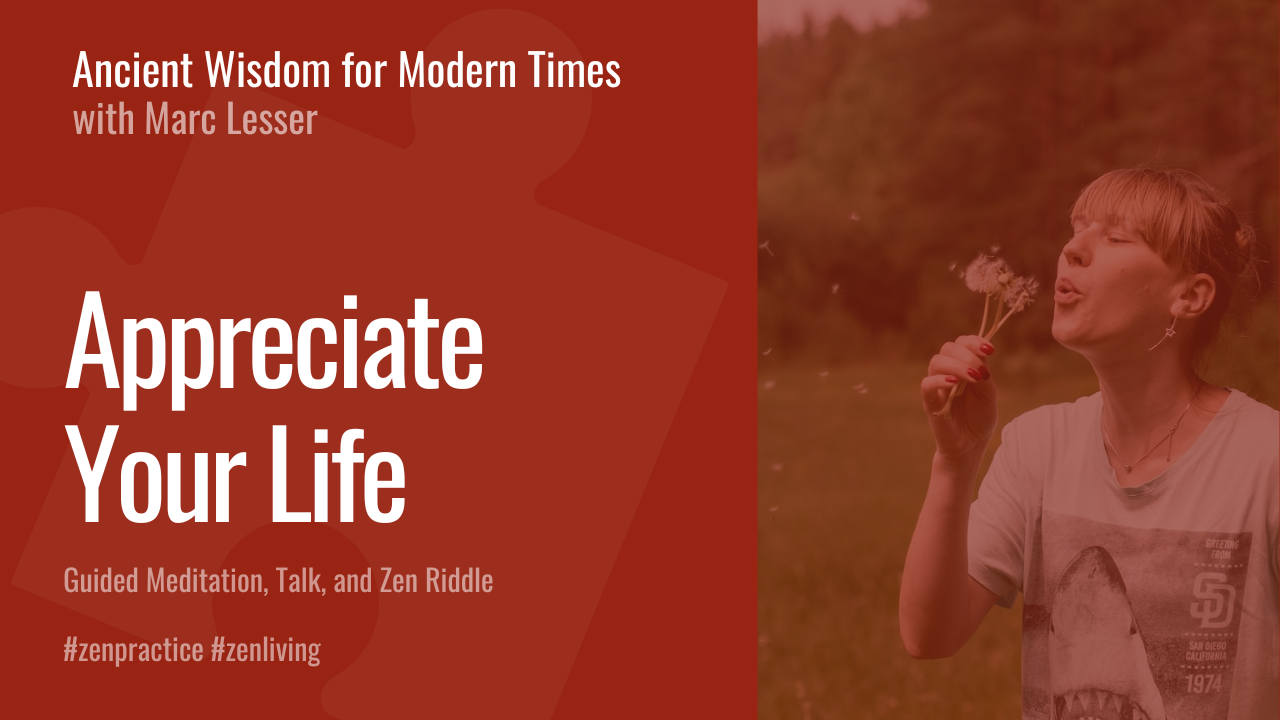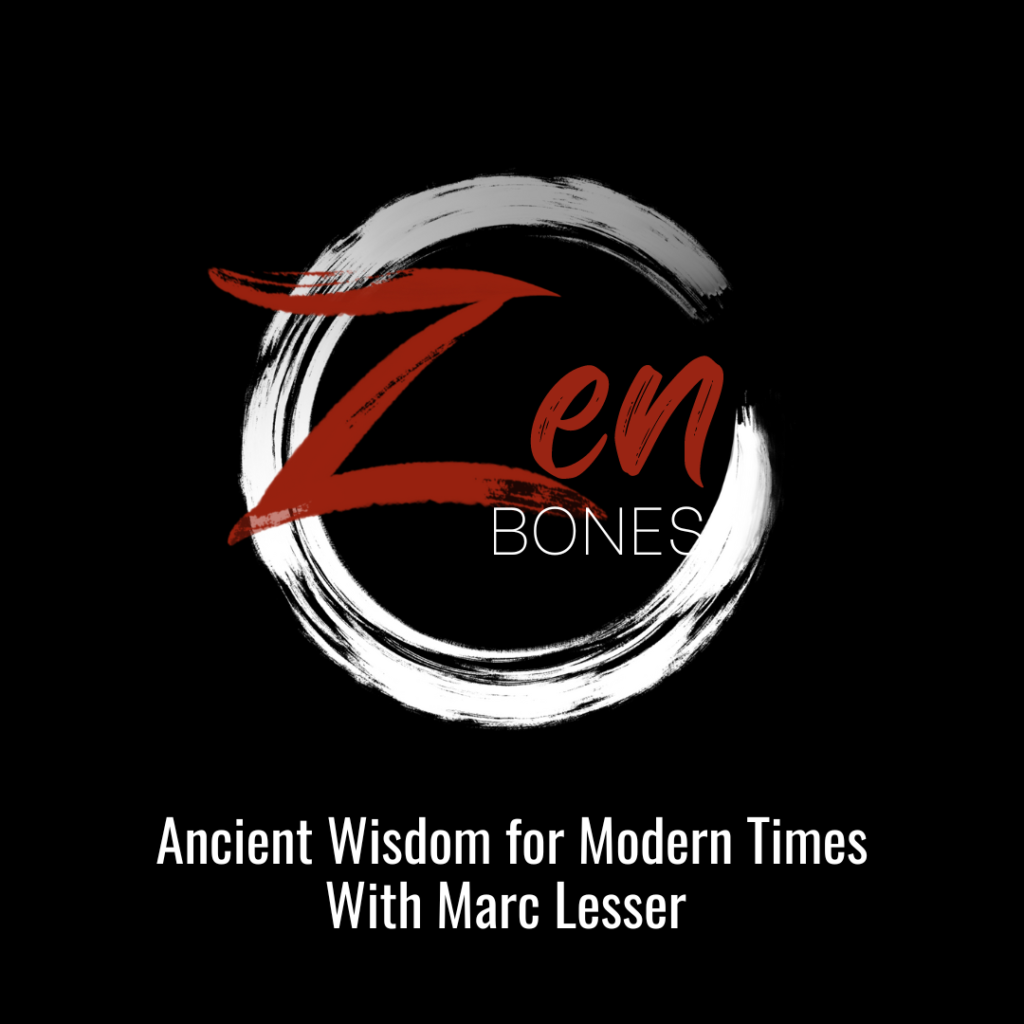In this practice episode, Marc begins with a short guided meditation with the theme of impermanence and appreciation, followed by a short talk on the practice of cultivating appreciation. The Zen puzzler is based on a short dialogue from Dogen, the 13th century founder of Zen in Japan, in which Dogen refers to his years of study in China as a lesson in how to appreciate everything life has to offer.
EPISODE TRANSCRIPT
[music]
Marc Lesser: Welcome to Zen Bones, ancient wisdom for modern times. This is Marc Lesser. Why Zen Bones? Our world is in crisis and ever-shifting, and now, more than ever, more wisdom, clarity, and courage are essential, especially in the world of work, business, and leadership. In this practice episode, we begin with a short guided meditation with the theme of embracing impermanence, as well as appreciation, appreciating your life and everything, followed by a short talk on this important topic of cultivating gratitude as well as appreciation.
Today’s Zen puzzler is a short dialogue from Dōgen, the 13th-century founder of Zen in Japan, where someone asks about what he learned from his years of study in China. His cryptic and also applicable response was, “I learned that eyes are horizontal, and nose is vertical.” A way of saying pay attention to what is most obvious, and appreciate everything. I hope you enjoy today’s episode
[music]
Let’s do a few minutes of sitting practice together.
[pause 00:01:24]
It’s the practice of pausing and stopping, just taking a few minutes, a few moments, to appreciate your life. [silence] Whether you’re feeling calm or not so calm, settled, not settled, happy or grieving, stopping and noticing, [silence] not just noticing, appreciating [silence] whatever’s happening. Not holding on too tightly, not pushing things away, [silence] being here right now, and bringing attention to the body. Opening our chest, shoulders, softening the belly, relaxing the muscles in the face and the jaw, and allowing breathing to be full and fluid.
No need to try and change anything, just noticing. [silence] Bringing attention to the breath, [silence] with a sense of curiosity and a childlike quality, as though we’re noticing the breath for the first time. This breath really is– We don’t have to pretend that this breath is unique, new, fresh, now. [silence] Simply breathing in and breathing out. Checking in, checking in with the body, checking in with the breath, letting the thinking mind do its thing. Thoughts will come and go, they’re coming back to the body, coming back to the breath.
Returning, coming back to your full experience, opening our minds, opening our hearts, to whatever is showing up now. What is it like to be here, breathing, feeling, alive? [silence] Think of that. Aligned from one of Rilke’s poems about– I don’t want to be hidden, I don’t want to be folded. This practice is a bit like unfolding ourselves, revealing ourselves to ourselves right now.
[pause 00:06:36]
Nothing to gain, nothing to lose. With each exhale, letting go of our usual comparisons and judgments, and just allowing your full experience right now. Appreciating everything, body, breath, feelings, thoughts. Experiencing your experience with as much presence, kindness, curiosity. [silence] What a relief, with nothing lacking, nothing to accomplish. [silence] I would invite you to continue sitting in this place for as long as it feels right, or you can join me for a short talk on this topic.
[music]
This is one of my favorite topics, appreciating our lives. I once published a greeting card that said, “The way you live your days is the way you live your life.” When my children were young, we used to have a weekly day of doing less. This was an important part of our family ritual. We borrowed some ideas from the Jewish Sabbath, as well as practices from the Buddhist day of mindfulness. At the heart of our day, we had three simple rules that we applied, starting at sundown on Friday evening until sundown on Saturday evening.
The first rule for this time was no spending money. The second was no watching television. These days, this would be no screens, no having any screens on. The third rule was, we did something together as a family during this time. These three guidelines actually produced really significant results in the quality of these 24 hours. What a relief, not to buy anything, not to have screens on, and to have time to enjoy each other’s presence. I noticed that both of us would talk more with our children.
We read books, we told stories, we played games. We’d go for walks and share preparing food, and having meals together. In a way, the largest benefit of this somewhat intentional and structured break was that, for a day, the pace of our lives slowed down. Somehow, our family connections increased, sometimes in small ways, sometimes more dramatically. One of my favorite parts of this ritual was a formal ending, and we chose to observe.
There’s a Jewish tradition of looking for the first three stars to become visible at the end of the day on Saturday. This was the signal that the day of mindfulness, or the Sabbath, was over. There was something fun and exciting for the four of us. My wife and two children would stand on our deck together, seeing who could find the three stars as the sun faded and nighttime slowly emerged. Of course, sometimes, since we live in the Bay area of San Francisco, the dense fog forced us to use our imaginations about these three stars.
Having a way to have more rest and simplicity in our lives is not some magic wand for perfection. Of course, there were, on these days, the usual disagreements, grumpiness, and sometimes boredom. Our imperfections often emerge was, sometimes, the most endearing parts of these Sabbath days, these days of mindfulness that stand out as many important sweet memories of our growing family. These days, in the midst of the intensity of our lives, these guidelines, they might seem quaint, as though they’re from another age.
I think it’s important to return to some simple rituals, whatever those are for you, that somehow revolve around returning, that revolve around taking the feeling, the benefits of meditation practice, of mindfulness practice, and integrating them into your daily life, whether it’s with your family, or by yourself. Having quality time, quality time by yourself, quality time with others, a way of returning, a way of connecting with the rhythms of the natural world.
A simple way to translate these guidelines is to experiment with, once a week, whether that’s Friday night, or whatever works for you, maybe it’s Sunday, to take some time where you are not purchasing anything. Let go of material concerns and activities. Let go of exploring, researching, or buying anything. Just experiment with that. The other is to have a radical media-free day. What might a day be like with no screens, no social media, no podcasts, perhaps a day that can include more time in nature, more being with others.
Simple, and for many of us, rather radical. The other guideline is to be intentional about doing something nourishing with friends or with family. Explore having real conversations, asking people to talk about their stories, their concerns, what’s bothering them, and what they’re appreciating. This is, I think, some simple practical ways to appreciate your life. I want to read a short piece about the power of appreciating our lives. This is by zen poet Ryōkan.
Returning to my native village after many years of absence, I put up at a country inn and listen to the rain. One robe, one bowl is all I have. I light incense and strain to sit in meditation. All night, a steady drizzle outside the dark window. Inside, poignant memories of these long ears of pilgrimage. Ryōkan, he was a zen monk in Japan some time ago, who decided to just leave the usual world and wandered around doing calligraphy, writing poetry, and experimenting with a number of ways of appreciating his life.
Returning to my native village after many years of absence, I put up at a country inn and listen to the rain. One robe, one bowl is all I have. I light incense and strain to sit in meditation. All night, a steady drizzle outside the dark window. Inside, poignant memories of these long ears of pilgrimage. Right now, in this moment, just noticing what it’s like to be here, noticing what it’s like to be alive, appreciating this moment, appreciating your life.
[music]
Welcome to the Zen Bones puzzler, where I will regularly be presenting a story, or a Zen koan, or a poem, something to contemplate, to think about, a story that has a purpose. It’s about developing greater insight and reflection, not so much for a solution, but as a way to support your practice, a meditation in daily life. Today’s Zen puzzler– This is actually a story. It’s not a traditional koan, as far as I’m aware. It’s just a story that I’ve read. I actually have to look up where this comes from.
A story about Dōgen, right? Dōgen was the founder of Zen Buddhism in Japan, in the 13th century, a prolific writer, thinker, and hugely influential of the teachings of Shunryu Suzuki, who was the founder of the San Francisco Zen Center. Many, many of today’s Zen teaching, Zen philosophy writing lean on, integrate, the teachings of Dōgen. From a very early age Dōgen had a very curious and deep mind. One of the stories is that he was at the funeral of his mother, I think he was nine or 10 years old.
He was, of course, deeply moved, and grieving. He was watching the smoke from the incense that had been lit at this ceremony appear and disappear. He wondered. He couldn’t help but wondering about birth, life, and death. He wanted to understand what it meant to be a full human being. He wanted to find his own sense of real freedom, equanimity, responsiveness. He spent years searching, in Japan, for teachers, and he was disappointed.
He came to the conclusion that if he really wanted to answer his most deep and compelling questions, he needed to go to China, which was a big deal. Again, in the 13th century, it meant taking a couple month trip, risking one’s life to go to China. He did find a variety of teachers that he thought were amazing. He also kept bumping into the head cooks of monasteries. There’s many stories about Dōgen and his dialogues with head cooks, how much he learned from people who were doing that work inside communities and monastic settings.
Today’s puzzler is– When he returned to Japan from China and went on to build a practice center, a monastery, that was thriving, and to this day, is actually the main practice training center in Japan, called Eihei-ji. Someone asked him, on his return trip, “What did you learn? What did you bring back from China after years of study and training there, and working with teachers?” One of his answers was, “Eyes are horizontal, and nose is vertical.” This is today’s Zen Puzzler.
What the hell did Dōgen mean by that? How might one work with that? I think the beauty of the Zen tradition is that it takes very simple, obvious ideas, experiences, and says, “Go deeper. Look more closely.” When we look in the mirror, or when we see another human being, how obvious, seeing someone’s eyes, and seeing someone’s nose, right? This is, I think, a radical appreciating what is, and appreciating your life. We get so lost in our stories and our thoughts, what’s going well, what’s not going well, our hopes and dreams.
All that is wonderful, but this, Dōgen comes back to eyes are horizontal and nose is vertical. What did you learn? In some way what he learned? One of the things he learned was to not be fooled by all of the things that are pulling at us, and to come back again and again to seeing, feeling, and living a life with appreciation, appreciating the most obvious parts of our lives. Eyes are horizontal and nose is vertical. You might experiment with this. I think the way these puzzlers are intended to be is to actually practice with them.
I sometimes like coming back. You can write down eyes are horizontal and nose is vertical. Then reflect on it. Write in a journal about it. Talk to someone about how does that work, influence your life. What did you learn? What is there to learn? Eyes are horizontal, nose is vertical. He might have said, “What I’ve learned is to appreciate everything. What I’ve learned is to devote my life to seeing more clearly, seeing what is, to be fooled less, and to appreciate everything.” Thank you.
[music]
Listen in each week for interviews, teachings, and guided meditations. You’ll receive supportive tools for creating more meaningful work, and mindfulness practices to develop yourself, to influence your organization, and to help change the world. Thank you for listening.
[00:25:48] [END OF AUDIO]









